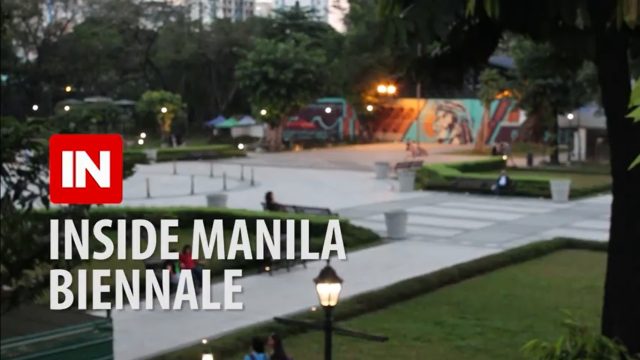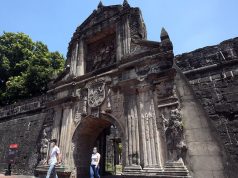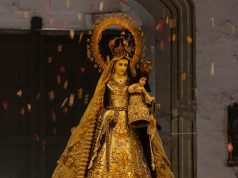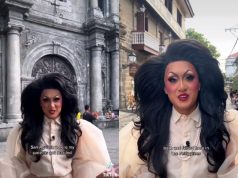The Walled City is THE place to be this National Arts Month, which also coincides with the 73rd anniversary of the battle for the liberation of Manila between the Americans and the Japanese.
The first Manila Biennale, pronounced “BAYAN-ale” according to tour guide and organizer Carlos Celdran, is underway in Intramuros, with the neighborhood playing host to art exhibits, film screenings, talks, food, shops, and even a costume ball. The festival which seeks to “bring back the soul of the city” runs until March 5.
In Baluarte de San Diego, the oldest stone fort in Manila, one can find Mideo Cruz’s Golgotha, an eerie collection of sculptural works which comes with a warning about “sensitive content” which “may not be suitable for all audiences.”
Overlooking a golf course is Zeus Bascon’s Dead Masks, a commemoration of war that includes the one that laid the Philippine capital to waste in 1945.

A calesa ride away is San Ignacio Church, still under restoration, and now home to Roberto Chabet’s Onethingafteranother, a sea of G.I. sheets surrounded by halogen lights.
Fr. Jason Dy’s Procesion los Camareros (Procession of the Caretakers) is in the same hall, a collaboration with 15 Intramuros pedicab drivers who turned their own life stories into 15 acrylic lightboxes.
Four floors packed with exhibits can be found next door at the Mission House, such as Elnora Ebillo’s WatAwat, a video projection on textile showing women’s role in Philippine history.
Pioneering photographer Teodulo Protomartir’s photos of the American flag going down and the Philippine flag being raised on July 4, 1946 are also on display. Rick Rocamora’s photos of Filipino veterans who fought alongside the Americans in World War II can also be seen.

Renz Baluyot, who experienced having a Japanese man kneel before him and ask forgiveness for the atrocities committed by the Japanese military during World War II, has a number of works on the subject. Zero, made of a plexiglass airplane wing and an antique mirror, and Smoke, an ammo box with a hologram, are among them.
A must-see is Japanese artist Hikaru Fujii’s Record of the Bombing, which he revealed was a response to the aborted plans in the 1990s “to construct a memorial hall in Tokyo to commemorate the victims of war and communicate the experience of war to future generations.”
“Incorporating displays that would have described Japanese aggression, the plans were disputed in the Metropolitan Assembly over their potential discrepancy from the official recognition of the war history, and there has been a freeze on funding for the project since 1999,” Fujii said.
In Fort Santiago, where national hero Jose Rizal was incarcerated, visitors can reflect on Agnes Arellano’s Angel of Death and Bronze Bullets, or on Pete Jimenez’s Walang Boots.

Some steps away is Parallel, Kolown’s take on “fake news”, and Felix Bacolor’s interpretation of the recent killings and conflict in Thirty Thousand Liters. Children of War, made of dolls Oca Villamiel scavenged from the Payatas dumpsite, is also worth a look.
Alwin Reamillo’s Bayanihan Hopping Spirit House, a playful break from the gravity of many of the works, is also nearby.
A one-day pass to the Manila Biennale is P880 for regular visitors and P550 for students. For those who wish to stop by Fort Santiago, Plaza Roma, Puerta Real, or Casa Manila, entrance fees are P75 for adults and P50 for students.
Tip: wear comfy shoes and clothes, bring drinking water, and come early. Visitors will need the whole day to take in the sights.










